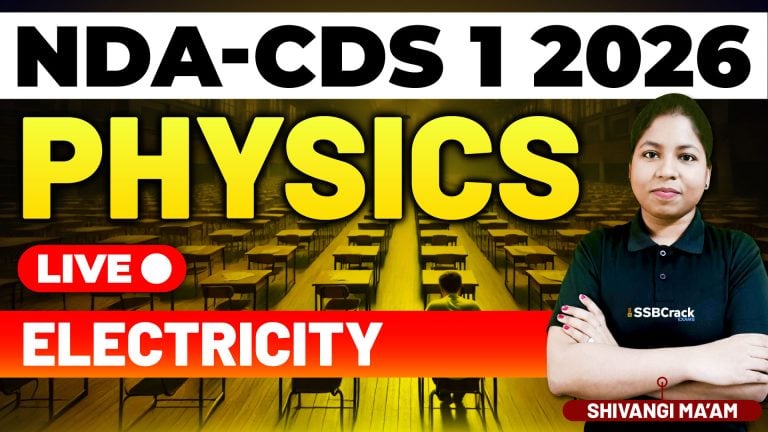Speed, Distance, and Time is one of the most essential and high-scoring topics in the Maths section of the Combined Defence Services (CDS) Exam. A recent class focused on two specific subtopics—Boat and Stream and Races—both of which are vital for developing a comprehensive understanding of this domain. These subtopics not only require a grasp of basic concepts but also demand the ability to apply logical reasoning to solve practical problems efficiently.
This blog will summarize the insights shared during the class and provide preparation strategies to help aspirants confidently tackle these topics in the CDS Exam.
Highlights of the Class
1. Boat and Stream
The discussion began with the fundamental concepts of boats navigating in still water versus moving streams. The focus was on the following key points:
- Upstream and Downstream Motion: The terms were clarified with practical examples, emphasizing the difference between moving against the stream (upstream) and with the stream (downstream).
- Relative Speed: Problems often involve determining the effective speed of a boat based on the speed of the stream and the boat’s speed in still water. The importance of distinguishing between these two cases was underscored.
- Time and Distance Problems: Students practiced questions involving boats traveling specific distances either upstream or downstream and were guided on how to handle scenarios where both directions are combined in one problem.
2. Races
The class then transitioned to the concept of races, which are common in the CDS Maths section. The focus here was on:
- Types of Races: Questions usually involve linear races, where participants run or move in a straight line over a specific distance.
- Lead and Lag: The discussion clarified terms like “lead by a certain distance” or “win by a certain time” and how to calculate such leads using logical reasoning.
Strategies to Prepare for Boat and Stream
- Understand the Basics
Get a clear grasp of the fundamental concepts of upstream, downstream, and relative speed. Understanding these concepts is crucial for solving both basic and advanced problems. - Practice Varied Problems
Solve questions involving boats traveling upstream and downstream over the same or different distances. This will help you handle diverse scenarios. - Focus on Time-Speed Relationships
Pay special attention to how speed affects time in upstream and downstream conditions. Practice calculating time taken for specific distances in both cases. - Real-Life Visualization
Try to visualize the scenario—a boat moving in a river with a current—to make sense of the question. This approach can simplify the problem and guide your solution. - Avoid Common Errors
Be cautious about misinterpreting the terms “still water speed” and “stream speed,” as confusing them can lead to incorrect answers.
Strategies to Prepare for Races
- Understand Relative Speed
Races often involve relative motion between participants. Practice calculating how one participant gains on another over a given distance or time. - Analyze Past Questions
Review previous years’ CDS questions on races to identify common patterns and approaches. - Work on Logical Reasoning
Races require quick reasoning to determine who finishes first or the time/distance by which one participant leads or lags. Practice problems to sharpen this skill. - Timed Practice
Solve race-related problems under timed conditions to develop speed and accuracy, essential for the CDS Exam. - Identify Keywords in Questions
Carefully read phrases like “wins by a distance” or “finishes in less time” to understand the specific requirement of the problem.
General Preparation Tips for Speed, Distance, and Time
- Master Unit Conversions: Ensure you are comfortable with converting units, as questions often require switching between kilometers per hour and meters per second.
- Simplify Problems: Break down complex problems into smaller steps. Visualizing or sketching the scenario can help you approach the problem more effectively.
- Learn Through Practice: Solve a mix of straightforward and challenging problems regularly to improve both conceptual clarity and problem-solving skills.
- Revise Regularly: Regular revision helps retain concepts and identify areas where improvement is needed.
- Focus on Speed and Accuracy: These are essential to solving Speed, Distance, and Time problems quickly and correctly during the exam.
Conclusion
The recent class on Boat and Stream and Races offered a valuable opportunity to dive deep into two essential subtopics of Speed, Distance, and Time. By focusing on practical application, real-life scenarios, and common exam patterns, the session equipped students with the tools needed to tackle these topics with confidence.
Preparation for these topics demands a mix of conceptual understanding, logical reasoning, and extensive practice. By following a structured approach and revising regularly, aspirants can turn these subtopics into high-scoring opportunities in the CDS Exam.
Stay focused, practice diligently, and navigate your way to success!



















